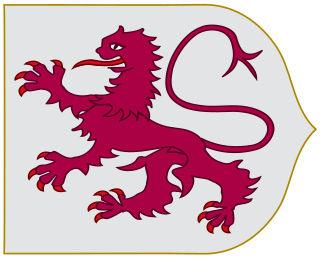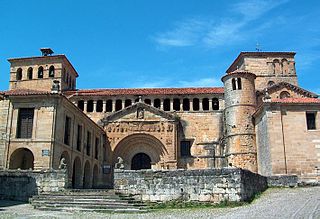
Asturias, officially the Principality of Asturias, is an autonomous community in north-west Spain. It is coextensive with the province of Asturias, and contains some of the territory that was part of the larger Kingdom of Asturias in the Middle Ages. Divided into eight comarcas (counties), the autonomous community of Asturias is bordered by Cantabria to the east, by Castile and León to the south, by Galicia to the west, and by the Bay of Biscay to the north.

León is a province of northwestern Spain, in the northwestern part of the autonomous community of Castile and León.

The province of Burgos is a province of northern Spain, in the northeastern part of the autonomous community of Castile and León. It is bordered by the provinces of Palencia, Cantabria, Vizcaya, Álava, La Rioja, Soria, Segovia, and Valladolid. Its capital is the city of Burgos.

Spain and its autonomous communities are divided into fifty provinces. Spain's provincial system was recognized in its 1978 constitution but its origin dates back to 1833. Ceuta, Melilla and the Plazas de soberanía are not part of any provinces.

Balmaseda is a town and municipality located in the province of Biscay, in the Basque Country. Balmaseda is the capital city of the comarca of Enkarterri, in western Biscay and serves an important role in the province thanks to its proximity to the capital city of Bilbao and the regions of Cantabria and Castile and León.
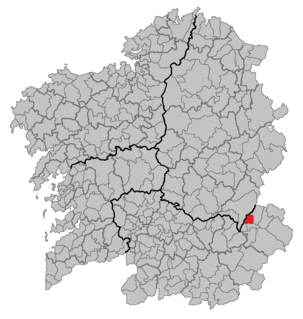
A Rúa is a mostly rural Galician municipality in the comarca of Valdeorras, eastern province of Ourense, 101 km (63 mi) from the provincial capital, Ourense. An inhabitant of the area is known as a Rués.

Peñamellera Baja is a municipality in the Autonomous Community of the Principality of Asturias, Spain. It is borderered to the north by Llanes and Ribadedeva, to the west by Peñamellera Alta, and to the east and south by the Autonomous Community of Cantabria.

Torrelavega is a municipality and important industrial and commercial hub in the single province Autonomous Community of Cantabria in northern Spain.

The Ribera del Duero is a comarca or district located at the southern tip of the province of Burgos, part of the Spanish autonomous community of Castile and León. The capital of the Ribera del Duero comarca or district is the town of Aranda de Duero.

Villablino is a municipality located in the Laciana comarca, province of León, Castile and León, Spain. According to the 2011 Census, the municipality had a population of 10,353 inhabitants. It has the largest commercial, economic and social center of Northwest province, and it is one of the judicial districts in the province of León.
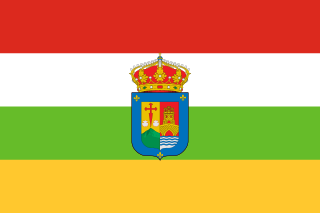
La Rioja is an autonomous community and a province in Spain, located in the north of the Iberian Peninsula. Its capital is Logroño. Other cities and towns in the province include Calahorra, Arnedo, Alfaro, Haro, Santo Domingo de la Calzada, and Nájera. It has an estimated population of 315,675 inhabitants, making it the least populated region of Spain.

The region of León or Leonese region is a historic territory defined by the 1833 Spanish administrative organisation. The Leonese region encompassed the provinces of Salamanca, Zamora, and León, now part of the modern Spanish autonomous community of Castile and León. As is the case with other historical regions, and continuing with centuries of history, the inhabitants of the Leonese region are still called Leonese. Even today, according with official autonomous government, the historical territorial adjective is used in addition with the modern annexed territory, the rest of Old Castile, being "Castilians and Leonese".

Montes de Oca is a comarca located east of the province of Burgos, in the autonomous community of Castile and León. It is bounded on the north by La Bureba, south by the Sierra de la Demanda comarca, on the east by the province of La Rioja and west by the Alfoz de Burgos.
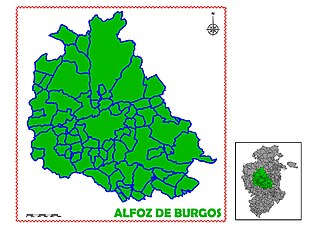
Alfoz de Burgos is a comarca located in the center of the province of Burgos, in the autonomous community of Castile and León. It is bounded on the north-west by La Bureba, north-east by the Páramos comarca, south-west by the Arlanza comarca, south-east by the Sierra de la Demanda, on the east by the Odra-Pisuerga comarca and west by the Montes de Oca.
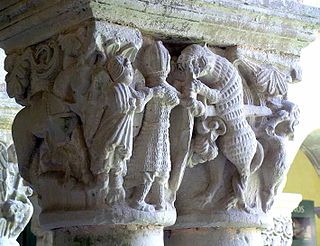
Rodrigo Muñoz, son of Count Munio González and Mayor Muñoz, was a Castilian magnate in the kingdoms of León and Castile. His tenancies were mostly in Cantabria, in the northern Castilian lands bordering the Basque country.

Comarca del Arlanza is a comarca located south-east of the province of Burgos in the autonomous community of Castile and León. It is bounded on the north by the Odra-Pisuerga and the Alfoz de Burgos, south by the Ribera del Duero, on the east by the province of Palencia and west by the Sierra de la Demanda.
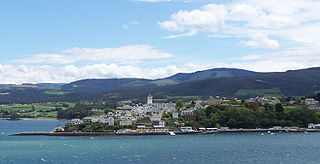
Old Common Council of Castropol, also Eo-Navia Land, Entrambasauguas or Honor de Suarón and Grandas is the name that was historically given to the sixteen westernmost villages of Asturias located between the Eo and Navia rivers. These villages belonged to the sixth sección or party that made up the Junta General del Principado, the historical governing body of Asturias. Episcopalías was composed by the following villages or concejos: Castropol, Rivera de Abajo, Rivera de Arriba, Langreo, Llanera, Quirós, Teverga, Noreña, Las Regueras, Navia, Morcín, Tudela, Proaza, Santo Adriano, Pajares, Riosa, Olloniego, Yernes y Tameza, Bimenes, Paderni, Sobrescobio and Peñaflor.

Asturias de Santillana is a historical comarca whose territory in large part corresponded to the central and western part of today's autonomous community of Cantabria, as well as the extreme east of Asturias. Most of the province of Asturias belonged to the comarca of Asturias de Oviedo. Also known also as a merindad and documented since the 13th century, Asturias de Santillana comprised the western part of Cantabria including the Saja River valley and the Nansa River. Its borders used to go along the coast from the council of Ribadedeva to the municipality of El Astillero, to the shores of the Bay of Santander), which leads to the administrative division of Trasmiera. From the south it went up to the Cantabrian cordillera. All of the valleys of this comarca are perpendicular to the coast.



